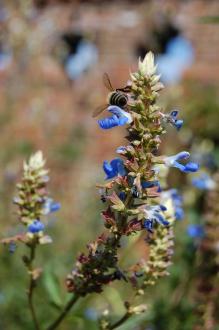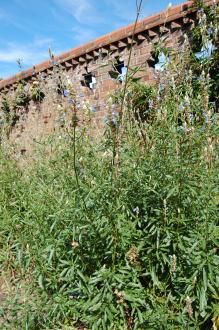
Salvia uliginosa Flower (08/09/2012, Kew Gardens, London)
Position: Full sun
Flowering period: Late summer to early autumn
Soil: Moist, well drained
Eventual Height: 2m
Eventual Spread: 90cm
Hardiness: 6a – 10a
Family: Lamiaceae
Salvia uliginosa is an upright deciduous, clump forming, herbaceous perennial. Its dark green leaves are lanceolate with serrate margins, up to 12cm long and 3cm broad. Its pale blue flowers are up to 15mm long and appear at the top of tall leafless stems, each flower spike flowering for several months. Its roots produce runners which aids its spread. This plant may spread readily, depending on climatic conditions.
Salvia uliginosa, commonly known as the Bog Sage, is native to south east South America, including south Brazil, Uruguay and Argentina. In its native habitat it grows in swampy or marshy places.
The etymological root of the binomial name Salvia is derived from the Latin salvare, meaning to ‘save’ or ‘heal’, in reference to its historical use as a medicinal plant. Uliginosa is from the Latin meaning ‘marshy’, in reference to its preferred growing conditions.

Salvia uliginosa (08/09/2012, Kew Gardens, London)
The landscape architect may find Salvia uliginosa useful as part of a mixed planting scheme, requiring the support of other plants to keep a tidy, upright appearance. It may be used as planting in ditches which receive surface water run off, as part of a SUDS scheme.
Ecologically, Salvia uliginosa flowers are attractive to pollinating insects. Some birds are attracted to this plant for its seed.
The Royal Horticultural Society has given Salvia uliginosa their prestigious Award of Garden Merit in 1993.
Salvia uliginosa prefers moist, humus rich, well-drained soils. It tolerates most pH of soil. It will tolerate wet soils.
Salvia uliginosa requires little maintenance. It may be cut to near ground level in spring to promote a more tidy appearance.

